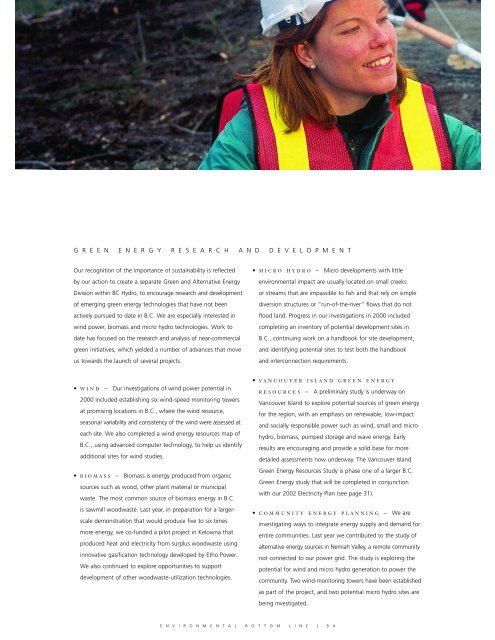2001 Triple Bottom Line Report - BC Hydro
2001 Triple Bottom Line Report - BC Hydro
2001 Triple Bottom Line Report - BC Hydro
Create successful ePaper yourself
Turn your PDF publications into a flip-book with our unique Google optimized e-Paper software.
G R E E N E N E R G Y R E S E A R C H A N D D E V E L O P M E N T<br />
Our recognition of the importance of sustainability is reflected<br />
by our action to create a separate Green and Alternative Energy<br />
Division within <strong>BC</strong> <strong>Hydro</strong>, to encourage research and development<br />
of emerging green energy technologies that have not been<br />
actively pursued to date in B.C. We are especially interested in<br />
wind power, biomass and micro hydro technologies. Work to<br />
date has focused on the research and analysis of near-commercial<br />
green initiatives, which yielded a number of advances that move<br />
us towards the launch of several projects.<br />
• WIND – Our investigations of wind power potential in<br />
2000 included establishing six wind-speed monitoring towers<br />
at promising locations in B.C., where the wind resource,<br />
seasonal variability and consistency of the wind were assessed at<br />
each site. We also completed a wind energy resources map of<br />
B.C., using advanced computer technology, to help us identify<br />
additional sites for wind studies.<br />
• BIOMASS – Biomass is energy produced from organic<br />
sources such as wood, other plant material or municipal<br />
waste. The most common source of biomass energy in B.C.<br />
is sawmill woodwaste. Last year, in preparation for a largerscale<br />
demonstration that would produce five to six times<br />
more energy, we co-funded a pilot project in Kelowna that<br />
produced heat and electricity from surplus woodwaste using<br />
innovative gasification technology developed by Etho Power.<br />
We also continued to explore opportunities to support<br />
development of other woodwaste-utilization technologies.<br />
• MICRO HYDRO – Micro developments with little<br />
environmental impact are usually located on small creeks<br />
or streams that are impassible to fish and that rely on simple<br />
diversion structures or “run-of-the-river” flows that do not<br />
flood land. Progress in our investigations in 2000 included<br />
completing an inventory of potential development sites in<br />
B.C., continuing work on a handbook for site development,<br />
and identifying potential sites to test both the handbook<br />
and interconnection requirements.<br />
• VANCOUVER ISLAND GREEN ENERGY<br />
RESOURCES – A preliminary study is underway on<br />
Vancouver Island to explore potential sources of green energy<br />
for the region, with an emphasis on renewable, low-impact<br />
and socially responsible power such as wind, small and micro<br />
hydro, biomass, pumped storage and wave energy. Early<br />
results are encouraging and provide a solid base for more<br />
detailed assessments now underway. The Vancouver Island<br />
Green Energy Resources Study is phase one of a larger B.C.<br />
Green Energy study that will be completed in conjunction<br />
with our 2002 Electricity Plan (see page 31).<br />
E N V I R O N M E N T A L B O T T O M L I N E | 5 4<br />
• COMMUNITY ENERGY PLANNING – We are<br />
investigating ways to integrate energy supply and demand for<br />
entire communities. Last year we contributed to the study of<br />
alternative energy sources in Nemiah Valley, a remote community<br />
not connected to our power grid. The study is exploring the<br />
potential for wind and micro hydro generation to power the<br />
community. Two wind-monitoring towers have been established<br />
as part of the project, and two potential micro hydro sites are<br />
being investigated.
















